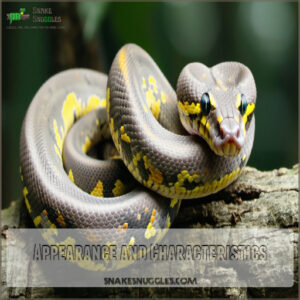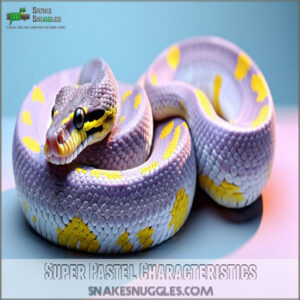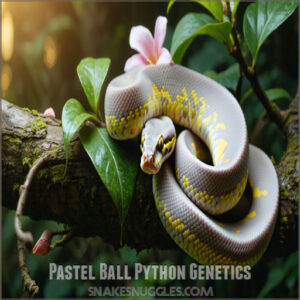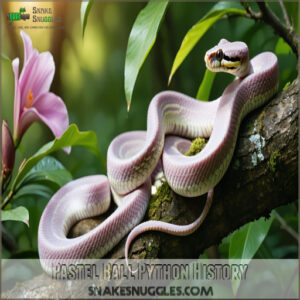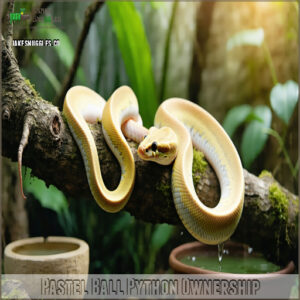This site is supported by our readers. We may earn a commission, at no cost to you, if you purchase through links.
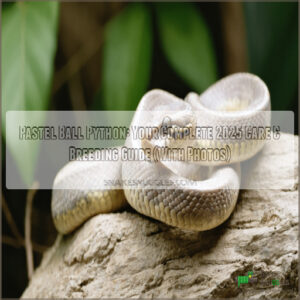
These snakes showcase sharp, dark markings with lighter patches called "blushes" and mesmerizing gold to green eyes.
As a co-dominant mutation, breeding two pastels can produce normal, pastel, and super pastel offspring.
You’ll need to maintain temperatures between 75-95°F and humidity at 50-60% in their enclosure.
While prices typically range from $100-$300, investing in a healthy specimen from a reputable breeder makes all the difference.
There’s more to these beauties than meets the eye.
Table Of Contents
- Key Takeaways
- Pastel Ball Python Basics
- Pastel Ball Python Genetics
- Pastel Ball Python Care
- Pastel Ball Python History
- Pastel Ball Python Ownership
- Frequently Asked Questions (FAQs)
- What is a pastel ball python?
- How to identify a Super Pastel Female Ball Python?
- What does a Super pastel ball python look like?
- Are Super pastel ball pythons good pets?
- How much does a pastel ball python cost?
- What is the average lifespan of a pastel ball python?
- Can I house pastel ball pythons together?
- What are good names for a pastel ball python?
- Can I feed my pastel ball python rabbits or chickens?
- What sounds and vocalizations do pastel ball pythons make?
- Conclusion
Key Takeaways
- You’ll recognize pastel ball pythons by their light yellow to burnt-orange coloration, sharply defined dark patterns, and gold to green eyes – they’re a co-dominant mutation that produces normal, pastel, and super pastel offspring when bred together.
- You’ll need to maintain specific conditions for your pastel ball python: temperatures between 75-95°F, humidity at 50-60%, and enclosure sizes ranging from 40 gallons for juveniles to 120 gallons for adults.
- You can expect to pay between $75-300 for a pastel ball python, with higher prices typically coming from reputable breeders who provide healthier, captive-bred snakes with proven genetics.
- You’ll find these snakes make excellent pets due to their docile nature and long lifespan of 20-30 years, but they must be housed individually to prevent stress and potential aggression.
Pastel Ball Python Basics
You’ll notice your pastel ball python stands out with its lighter coloration and distinctive yellow to burnt-orange patterns replacing the typical brown pigment.
When you examine its features more closely, you’ll see the sharply defined dark patterns with lighter patches called "blushes," along with striking light-colored eyes in gold or green shades.
Appearance and Characteristics
The beauty of a pastel ball python lies in its distinctive appearance, setting it apart from typical ball pythons.
You’ll notice these stunning snakes showcase lighter coloration, with rich yellows and burnt oranges replacing traditional brown tones.
Their dark patterns create striking contrasts against lighter patches.
- Eye colors range from mesmerizing gold to ethereal green shades
- Scale texture features a unique blend of blushes and clean patterns
- Head shape displays sharp definition with lighter undertones
Pastel Mutation Characteristics
The pastel ball python’s mutation creates a stunning transformation of your snake’s appearance.
This genetic trait intensifies yellow pigmentation throughout the body, creating vibrant pastel colors that catch everyone’s eye.
You’ll notice distinctive features like high blushing intensity along the sides, alluring green or pale eyes, and pristine white lips.
The scale patterns show remarkable clarity, with each pastel morph displaying a uniquely clean underside that sets it apart, showcasing remarkable clarity and a stunning transformation.
Super Pastel Characteristics
When you breed two pastel ball pythons together, you’ve got a chance to create a super pastel – a stunning morph with reduced patterns and higher color intensity.
Proper housing and care are essential for their well-being, so understanding their specific dietary needs is key.
You’ll notice these beauties keep their yellow coloration while showing off extensive blushing with a signature purple-haze effect.
Their faded heads and distinct pattern reduction make them a prized find among ball python genetics enthusiasts.
Pastel Ball Python Genetics
You’ll find that pastel ball python genetics follows a co-dominant inheritance pattern, where a single copy of the gene produces the classic pastel appearance while two copies create the striking super pastel form.
When you breed two pastel ball pythons together, you’ll get a mix of normal, pastel, and super pastel offspring in a predictable 1:2:1 ratio, making it an excellent choice for both beginners and experienced breeders who value predictable outcomes.
Co-Dominant Mutation
Understanding the genetic code behind these fascinating snakes reveals a fascinating pattern.
The pastel ball python’s codominant mutation means the genetic mutation shows unique traits even with a single copy of the gene.
When you’re examining ball python genetics, you’ll notice the pastel morph expresses varying levels of dominance – it’s like having a volume control for gene expression, creating stunning visual effects.
This complexity is influenced by genetic variations and codominant gene interactions that affect the snake’s phenotype with genetic variations.
Breeding Outcomes
When you pair two Pastel ball pythons, you’ll get a fascinating mix in your clutch: 25% Super Pastels with their striking purple haze, 50% regular Pastels showing those classic yellow patterns, and 25% normal ball pythons.
These beautiful snakes are excellent for beginners.
If you’re breeding with a normal ball python instead, expect a simpler 50-50 split between Pastel and normal offspring. It’s genetic math in action!
Genetic Inheritance
The genetic code of your pastel ball python follows a fascinating inheritance pattern that’s easier to understand than you might think.
When discussing gene expression, these snakes carry a co-dominant mutation that creates their stunning appearance.
- One copy of the genetic mutation produces the classic pastel traits: yellow scales, blushing, and pale eyes
- Two copies result in a Super Pastel with brighter colors and enhanced patterns
The dominant traits consistently pass down through generations, making breeding outcomes predictable.
Understanding the pastel ball python genetics is important for successful breeding and care.
Pastel Ball Python Care
You’ll need to provide your pastel ball python with specific environmental conditions, including a temperature gradient between 75-95°F and proper enclosure sizing from 40 gallons for juveniles to 120 gallons for adults.
While these beautiful morphs share the same care requirements as regular ball pythons, they’ll thrive in a setup that includes proper hiding spots, fresh water, and consistent humidity levels between 50-60%.
Enclosure Size and Dimensions
Setting up your pastel ball python’s home doesn’t have to break the bank. You’ll need different enclosure sizes as your snake grows, focusing on proper cage requirements and ventilation needs.
Here’s a quick guide to help you choose the right housing:
| Snake Age | Tank Size | Additional Features |
|---|---|---|
| Hatchling | 10-20 gallon | Extra hiding spots |
| Juvenile | 30-40 gallon | Humidity box |
| Adult | 120 gallon | Multiple hides |
Proper ball python enclosures are Paramount for the health and well-being of your pet. Remember, a happy snake needs room to stretch, climb, and explore their space comfortably, which is why proper cage requirements and a suitable environment are crucial for their development.
Temperature and Lighting
Your pastel ball python’s comfort depends heavily on maintaining proper temperature gradients and lighting cycles.
You’ll need to create distinct temperature zones within their enclosure to mimic their natural habitat.
Here’s what you’ll need to monitor:
- Cool side temperature: 75-80°F for resting and digestion
- Warm side temperature: 84-89°F for activity
- Basking spot: 90-94°F for thermoregulation
- Nighttime temperature: 72-80°F for sleep cycles
- Heat sources: Use a combination of ceramic heaters and heat lamps
Maintaining the essential temperature humidity levels is vital for your pastel ball python’s health and well-being.
Humidity and Feeding
Maintaining proper humidity levels is essential for your pastel ball python’s health.
Keep the enclosure’s humidity between 50-60% by misting the enclosure daily and providing a large water bowl.
Feed your snake appropriately sized prey every 7-10 days – the meal should be no larger than the widest part of their body.
Always offer fresh, clean water and monitor substrate moisture to prevent scale rot.
To make sure accurate readings, use a device that measures humidity gauge levels in the enclosure to ensure accurate humidity control.
Pastel Ball Python History
You’ll find the Pastel Ball Python’s story begins in 1997 when breeders first discovered this striking co-dominant mutation.
This foundational morph, pioneered by experts like NERD and Amir Soleymani, has become a cornerstone of modern ball python breeding, with specimens typically available for $75-100, showcasing the striking co-dominant mutation.
Origin and Development
While you’ve mastered the art of ball python care, you’ll love knowing the story behind your pet.
The pastel ball python morph emerged in 1997 through the groundbreaking work of Greg Graziani and Kevin McCurley at NERD.
Their genetic research revealed the ball python pastel gene, establishing the founder lineage that revolutionized morph development.
Understanding pastel ball python care is essential for responsible pet ownership.
Today, this discovery stands as one of the first successfully reproduced mutations in the hobby.
Popular Combinations
When you venture into breeding Pastel Ball Python crosses, you’ll discover a rainbow of stunning genetic pairings.
You can create remarkable color combinations by mixing Pastel morphs with other variants.
Here are some popular combinations that breeders love:
- Pastel x Axanthic: Creates ghostly Axanthic Pastels with unique grayscale patterns
- Pastel x Banana: Produces intensely yellow offspring with heightened brightness
- Pastel x Clown: Yields eye-catching Pastel Clowns with enhanced contrast
- Pastel x Piebald: Results in specimens with lighter saddles and vibrant hues
Pastel Ball Python Ownership
You’ll find that owning a Pastel Ball Python combines the joy of caring for a docile pet with the thrill of having a genetically unique morph that typically costs between $75-100.
Your investment in this co-dominant mutation gives you access to one of the hobby’s most versatile breeding morphs, known for its distinctive yellow coloration and potential for creating stunning combinations.
Temperament and Handling
Regarding handling techniques, your pastel ball python will likely become one of your most laid-back pets.
These snakes display a remarkably docile nature, making them perfect for beginners and experts alike.
Here’s a quick guide to their behavior patterns:
| Behavior | Meaning | Handling Response |
|---|---|---|
| Tongue Flicking | Exploring | Continue Gentle Handling |
| Ball Position | Nervous | Give Space, Try Later |
| Straight Posture | Comfortable | Perfect for Interaction |
Trust-building with your snake starts with short, consistent handling sessions, usually 10-15 minutes at a time.
They’ll curl around your hands and arms comfortably once they’re used to you, which is a sign of trust and comfort in their handling environment.
Buying and Pricing
Now that you’re comfortable handling your snake, let’s talk about bringing one home.
You’ll find pastel ball python prices typically range from $100-$300, making them an accessible choice for new snake owners.
When shopping for your pastel ball python, keep these key factors in mind:
- Reputable breeders often charge more but provide healthier, captive-bred snakes with proven genetics
- Pet stores might offer lower prices, but may lack detailed morph information
- Online marketplaces and reptile expos give you more options to compare prices and breeders
Researching the pastel ball python price is essential to making an informed decision, and considering the reputable breeders and their impact on the snake’s health is crucial.
Potential Problems and Health Issues
While your pastel ball python’s price tag is now settled, keeping an eye on their health is your next priority.
These snakes can face several challenges, from common respiratory infections and scale rot to specific genetic disorders.
Some super forms may develop skeletal issues like duck bills or bug eyes.
Regular vet check-ups, proper humidity levels, and careful monitoring help prevent most health risks and shedding problems.
Ensuring the well-being of your pet is crucial, and with the right care, you can help your pastel ball python thrive and avoid potential genetic disorders.
Frequently Asked Questions (FAQs)
What is a pastel ball python?
You’ll find this snake’s stunning yellow-to-orange coloration replaces typical brown pigments.
It’s a co-dominant morph with sharply defined patterns, light-colored eyes, and distinctive blushing that makes it incredibly popular among reptile enthusiasts.
How to identify a Super Pastel Female Ball Python?
Like a shimmering treasure in your collection, you’ll spot a Super Pastel female by her bright yellow coloring, reduced pattern, extensive purple-haze blushing, and distinctly faded head compared to regular Pastels.
This description highlights the key characteristics of a Super Pastel female, including bright yellow coloring.
What does a Super pastel ball python look like?
You’ll notice these incredible snakes display brighter yellows and reduced patterns compared to regular morphs.
Their heads appear faded with extensive purple-haze blushing, while distinctive green eyes and clean white bellies complete their stunning appearance, showcasing incredible snakes.
Are Super pastel ball pythons good pets?
Beauty is more than skin deep!
You’ll find these snakes make wonderful pets with their docile nature and striking colors.
They’re easy to handle, maintain healthy appetites, and thrive in basic setups.
How much does a pastel ball python cost?
You’ll spend between $75-100 for a basic pastel morph, while fancier combinations like Ivory can reach $ Most pet stores and breeders price standard pastels around $79 for babies.
What is the average lifespan of a pastel ball python?
Time flies when you’re caring for these remarkable creatures.
Your pet will typically live 20-30 years with proper care, making them a long-term companion that’ll share many special moments with you.
Can I house pastel ball pythons together?
You shouldn’t house them together since they’re solitary creatures.
They’ll become stressed and may fight or even eat each other.
Keep your snakes in separate enclosures to guarantee their safety and well-being.
What are good names for a pastel ball python?
Consider naming your snake after its yellow hues like Sunshine or Buttercup.
You can also pick mythological names like Apollo or Luna, or fun choices like Noodle, Zigzag, or Pretzel that match their pattern.
Can I feed my pastel ball python rabbits or chickens?
Don’t feed your snake rabbits or chickens – they’re too large and can harm your pet.
Stick to appropriately sized mice and rats based on your snake’s age and size for safe, healthy meals.
What sounds and vocalizations do pastel ball pythons make?
Like a whisper in the night, your snake stays mostly silent.
You’ll hear soft hissing when stressed, and they might make gentle puffing sounds during exploration.
Expect no barks or growls from these quiet pets.
Conclusion
Whether you’re a first-time keeper or seasoned enthusiast, the pastel ball python offers a rewarding experience.
You’ll find their docile nature and stunning appearance make them excellent pets.
By maintaining proper temperatures, humidity levels, and following our care guidelines, you’ll provide your snake with a thriving environment.
Remember, every pastel ball python has unique patterns and personality quirks that make them special, and with proper care, your snake can live 20-30 years as your scaled companion.
- https://www.worldofballpythons.com/morphs/pastel/
- https://www.morphmarket.com/morphpedia/ball-pythons/pastel/
- https://www.xyzreptiles.com/reptiles/animals/snakes-for-sale/ball-pythons-for-sale/pastel-ball-pythons/
- https://www.bigappleherp.com/collections/ball-pythons/ball-pythons
- https://community.morphmarket.com/t/morphpedia-ball-pythons-black-pastel/21566

